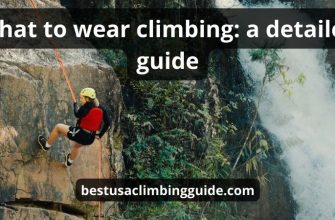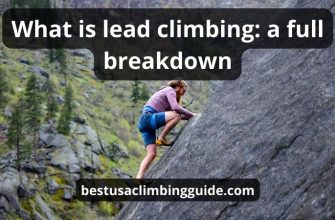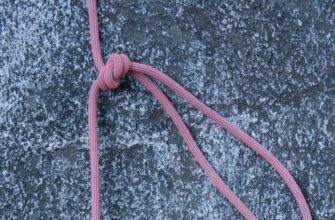Is Bouldering Dangerous? If you’ve ever looked at a massive boulder and wondered, “Could I climb that?” – you’re not alone. Bouldering, a captivating form of rock climbing, has been taking the world by storm.
From indoor rock climbing and indoor bouldering to outdoor climbing havens, more and more people are getting drawn into this adventurous and physically demanding activity.

- The Bouldering Buzz
- Is bouldering dangerous?
- Bouldering Unpacked
- Injury insight
- The Upsides of Bouldering
- Indoor Bouldering: Balancing Risk and Reward
- Bouldering Outdoors: Navigating Nature’s Obstacles
- Mastering the Craft: Training and Technique
- From Gym to Crag: a Gradual Approach
- FAQ
- Is it dangerous to fall bouldering?
- Are injuries common in bouldering?
- Is bouldering more dangerous than lead?
- Conclusion: Embrace the Adventure, Safely
The Bouldering Buzz
Bouldering isn’t just a niche pursuit anymore; it’s a full-fledged craze. Both indoor and outdoor bouldering are gaining ground as thrilling pastimes for people of all ages and fitness levels. What’s the allure, you ask? It’s all about the challenge.
Bouldering strips rock climbing down to its core, focusing on short, powerful routes that require technique, strength, and quick thinking. Picture yourself navigating a vertical puzzle, relying on your wits and muscles to conquer nature’s obstacles.
Is bouldering dangerous?
Buckle up as we delve into the highs, lows, and safety ropes (or lack thereof) of this exhilarating sport.
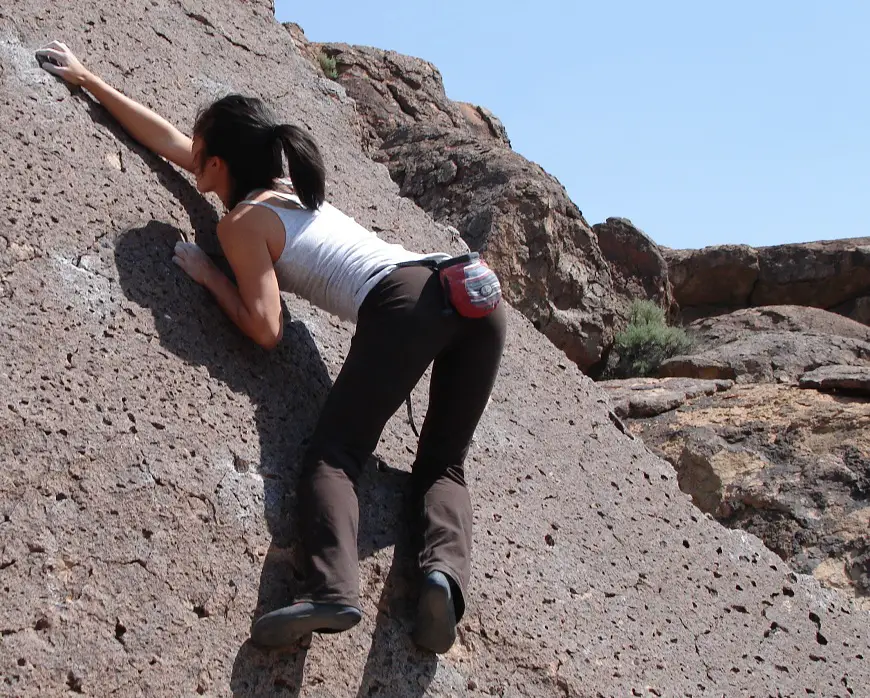
Bouldering Unpacked
Rock climbing is a broad range of sports, from indoor rock climbing and bouldering to rope climbing and free soloing.
Let’s start by cracking open the bouldering nutshell. Climbers tackle relatively shorter routes, or “problems,” typically no higher than 20 feet, sans any safety harnesses.
What’s the catch? The landing zone. That’s where climbing pads, affectionately known as “crash pads“, come into play. These cushy lifesavers are designed to cushion your fall and prevent any serious injuries.
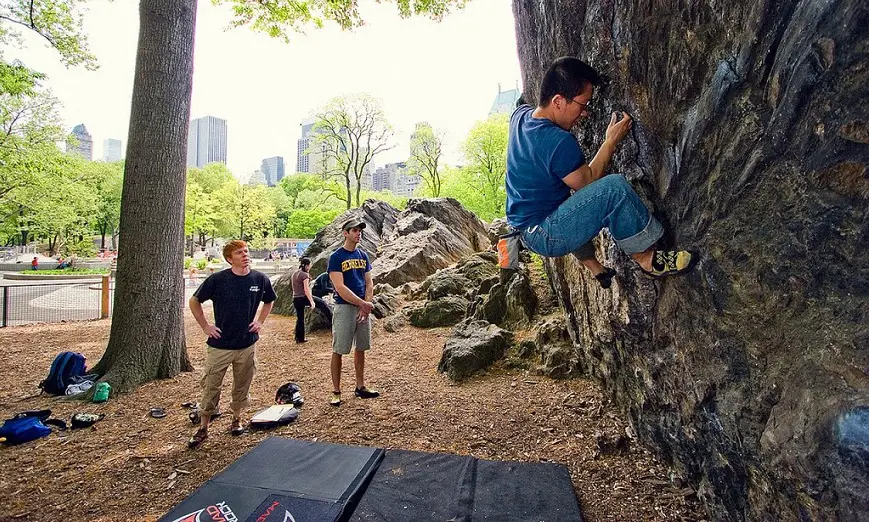
Injury insight
Common Injuries from climbing-related activities can range from minor skin injuries to broken ankles and neck injuries.
Finger injuries, often a result of intense holds, are common due to the repetitive stress on these digits.
Proper training, technique refinement, and adherence to safety measures significantly lower the risk of most injuries. Taking time to warm up, cool down, and practice falling techniques can go a long way in injury prevention.
The Upsides of Bouldering
Before we jump into the realm of bouldering’s risks, let’s shine a light on why so many folks are smitten by it. This isn’t just a dangerous sport – it’s a rewarding one too.
Physical Benefits. Bouldering is a full-body workout extravaganza. It builds strength in muscles you didn’t even know existed, enhances your flexibility as you stretch and reach for holds, and boosts your cardiovascular endurance as you power through those problems.
Accessible Adventure. The beauty of bouldering lies in its approachability. You don’t need a laundry list of gear – just climbing shoes and perhaps a chalk bag.
Indoor bouldering is particularly friendly to beginners, providing a controlled environment to learn the ropes – or lack thereof.
Indoor bouldering is considered safer than other dangerous forms of rock climbing.
Victory and Camaraderie. Conquering a particularly tricky problem feels like you’ve won a gold medal. And it’s not just the sense of achievement that’ll keep you coming back.
Bouldering fosters a tight-knit community of climbers who cheer each other on, share beta (that’s climbing lingo for advice), and celebrate every send – climbing lingo for success.
Indoor Bouldering: Balancing Risk and Reward
As you step into the vibrant world of indoor rock climbing gyms, you might find yourself wondering, “Is indoor bouldering dangerous?”. Let’s untangle this web of excitement and safety.
Controlled Climbing. The controlled environment of indoor bouldering gyms offers a safety net, reducing some of the inherent risks associated with rock climbing on actual cliffs and mountains. You’re shielded from the unpredictability of weather and enjoy consistent terrain.
Potential Risks. However, that doesn’t mean indoor bouldering is risk-free. Falls are still a concern, even with those cushy crash pads beneath you. Overexertion and improper landing techniques can lead to injuries, ranging from minor sprains to more serious fractures.
Safety Measures Inside. Fear not, indoor bouldering gyms prioritize safety. Routes are carefully designed and marked, ensuring climbers follow controlled paths.
Crash pads are strategically placed to create a soft landing zone. Plus, trained staff members are on standby, ready to guide and assist.
Warm-Up, Cool-Down, and Gym Etiquette. Climbing safely indoors isn’t just about the gear. Proper warm-up and cool-down routines are essential to prevent most injuries.
Adhering to gym rules and guidelines helps maintain a safe and supportive community, ensuring everyone’s well-being.
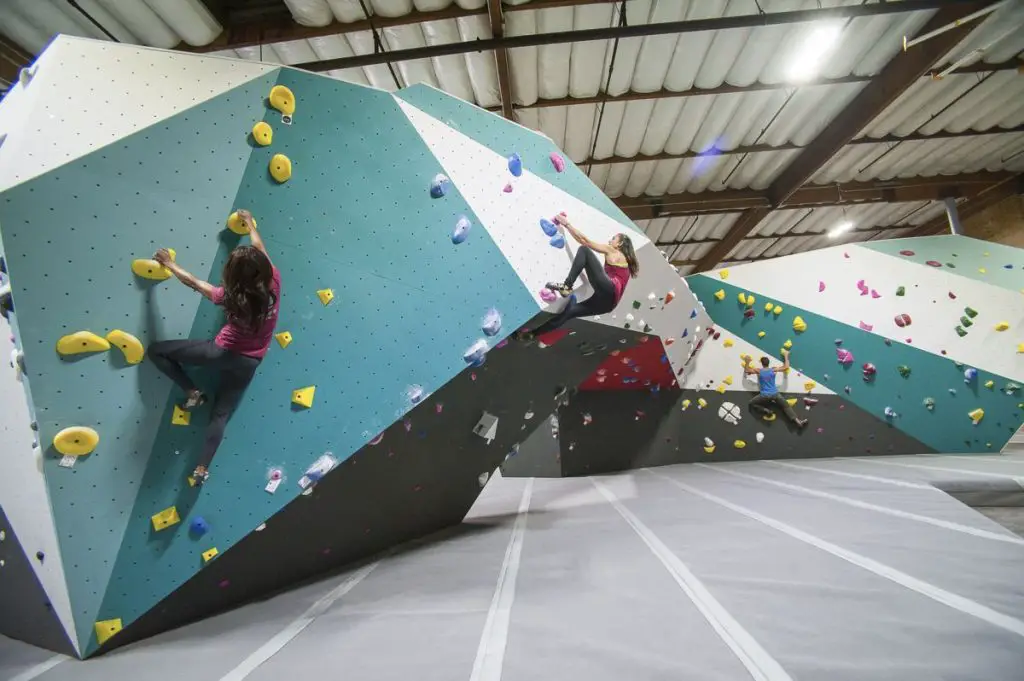
Bouldering Outdoors: Navigating Nature’s Obstacles
Now, picture this: you’re out in the wild, surrounded by nature’s breathtaking beauty, ready to conquer the challenges of outdoor bouldering. But as you scale those rocks, remember, Mother Nature plays by her own rules.
When we discuss how dangerous bouldering is, it’s important to remember that despite technically being the same sport, bouldering outdoors is more dangerous than climbing in a bouldering gym.
Nature’s Curveballs. Outdoor bouldering presents a different set of risks. Unpredictable weather conditions can turn a sunny day into a slippery situation. Uneven terrain adds an extra layer of complexity, demanding precise footwork and balance. And let’s not forget the curious critters that might decide to join your climb.
Route Assessment and Spotting. Unlike indoor routes, outdoor problems aren’t color-coded or marked. Climbers need to assess potential hazards, like loose holds or tricky sections.
Many climbers will tell you that having a spotter – a friend who helps guide your fall – becomes crucial to minimize risks.
Essential Gear and Preparedness. As you venture into the great outdoors, packing the right gear becomes paramount. Crash pads are still your friends, providing that all-important cushion. Carrying essentials like first aid kits, extra clothing, and weather-appropriate gear ensures you’re ready for anything.
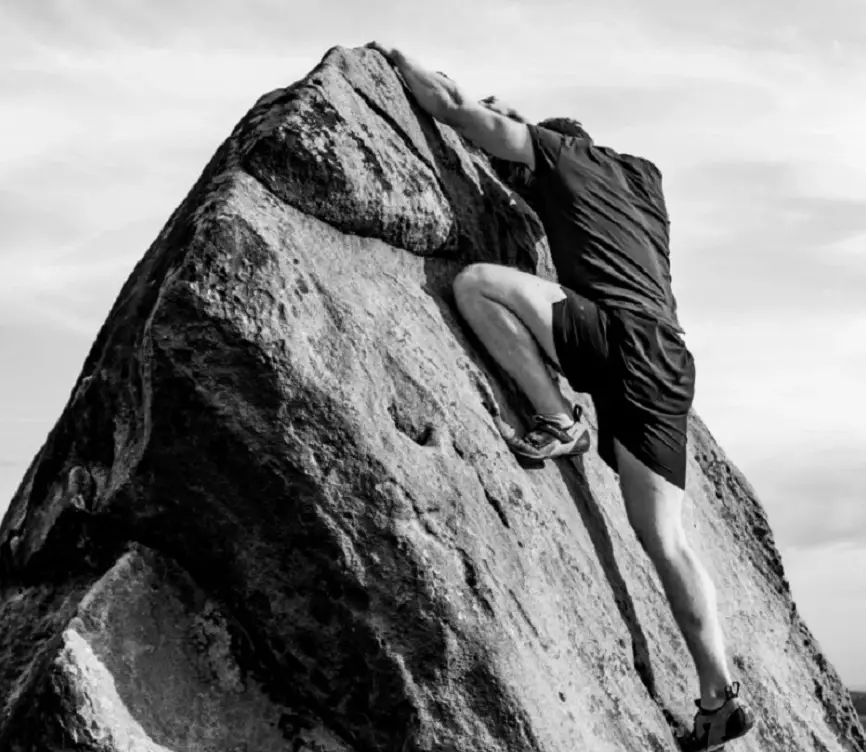
Mastering the Craft: Training and Technique
The journey to safer bouldering begins with you, the climber. It’s all about mastering the art of technique, developing your skills, and progressing at a pace that suits you. While bouldering might look like a straightforward rock climb, there’s a lot more under the surface.
Climbing Classes and Instructional Videos. Enrolling in climbing classes or watching instructional videos can be invaluable. Seasoned climbers share their wisdom, teaching you the ins and outs of safe bouldering techniques. You’ll learn proper footwork, hand placements, and how to distribute your weight efficiently to conquer those problems.
Guidance from Experienced Climbers. Don’t be shy – seek guidance from experienced climbers at your local bouldering gym or outdoor crags. Climbing is a community, and climbers are often more than willing to offer advice and tips to newcomers. Their insights can make a world of difference in your journey.
From Gym to Crag: a Gradual Approach
Indoor Bouldering Foundation. If you’re new to the scene, consider starting your bouldering journey indoors. Bouldering gyms provide a controlled environment where you can hone your skills and build a solid foundation. It’s the perfect playground for beginners, offering a range of routes that cater to different skill levels.
Venturing Outdoors. Once you’ve gained confidence and a level of proficiency indoors, you might feel ready to tackle the challenges of outdoor bouldering.
But remember, outdoor climbing comes with its own set of tests – from unpredictable weather to unfamiliar terrain.
Take your time, do your research, and never underestimate the power of preparation.
FAQ
Is it dangerous to fall bouldering?
When you’re navigating the heights of a boulder problem, falling is an inevitable part of the journey. So, is it dangerous? Falling during bouldering can certainly carry risks, but it’s all about how you approach it.
Proper Falling Technique. Mastering the art of falling is a crucial skill. Learning to land on your feet, rolling to disperse impact, and even embracing the well-practiced “boulderer’s flop” can help minimize the chances of serious injury.
Landing Zone and Crash Pads. The landing zone, covered by crash pads, plays a pivotal role in ensuring your safety. These trusty pads create a cushion that absorbs the impact, minimizing the risks of minor injury.
Is bouldering more dangerous than sport climbing?
Comparing bouldering and sport climbing in the safety arena is like comparing apples and oranges – they each have their own flavor of risk.
Bouldering might expose you to the risk of falls from relatively lower heights. Can you spring your ankle bouldering, or damage up your knee joints after a bad fall? Absolutely, but the risk is compensated with crash pads and a focus on controlled routes. Proper falling technique and warm-up can go a long way to reducing the risk of injury.
Sport climbing involves longer routes, usually with ropes and harnesses. While you’re protected by equipment and belay systems, the risk of injury is still there, and longer falls can potentially lead to different kinds of injuries.
Yet, the reliance on gear provides a layer of safety not always present in bouldering.
Are injuries common in bouldering?
Injuries and climbing share a complex relationship, regardless of the form. So, are bouldering injuries common? Yes, they can happen, but they’re not an inevitable consequence.
When it comes to bouldering, a few bumps and scrapes are all part of the adventure. Finger injuries, like the occasional battle scar, can happen, but don’t let that hold you back.
And as for ligament injuries, they’re like the rare surprise guest – not always expected, but with proper precautions, you can keep them at bay and keep on climbing.
Is bouldering more dangerous than lead?
As the dust settles on the question of bouldering’s risks, a new contender enters the ring: lead climbing. Is bouldering more dangerous than lead climbing? It’s a nuanced contest of skills and systems.
Shorter problems and controlled environments make bouldering somewhat forgiving in terms of potential falls. While injuries can still occur, the risks are often different in nature from those encountered in lead climbing.
Lead climbing involves ascending longer routes with protection placed intermittently. While falls can be significant, the safety net of ropes, harnesses, and belay systems provides a crucial layer of protection against free falls.
In the grand tapestry of rock climbing, each style has its own palette of risks and rewards. The key to a safe and enjoyable climbing experience, whether bouldering, sport climbing, or lead climbing, lies in mastering technique, embracing safety measures, and respecting the unique challenges each style brings to the table.
Conclusion: Embrace the Adventure, Safely
Whether you’re scaling a boulder indoors or conquering nature’s challenges outside, acknowledge the potential risks. Head injuries, broken bones, and minor injuries are all part of the equation, but they don’t have to define your experience.
Just like any skill, bouldering requires continuous learning and improvement. Approach it with caution, respect for the sport, and a commitment to enhancing your technique and safety knowledge.
So, is bouldering dangerous? It can be, but armed with knowledge, training, and a dash of common sense, you can embark on this thrilling journey with confidence.
Embrace the adventure, climb with caution, and let the rock-fueled exhilaration guide you as you ascend to new heights – one boulder at a time.




